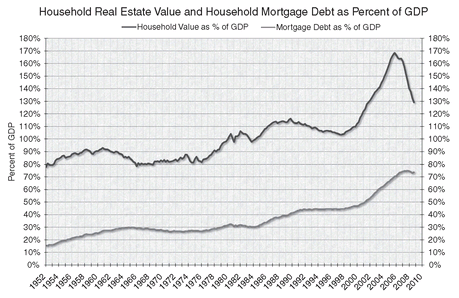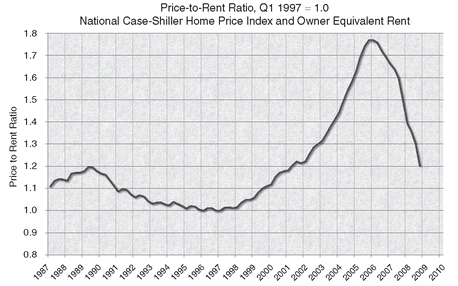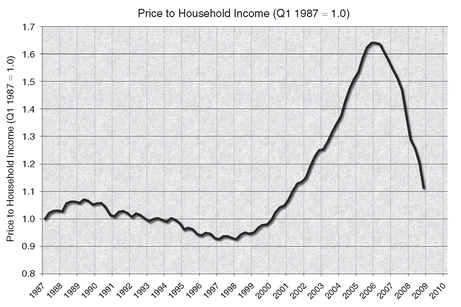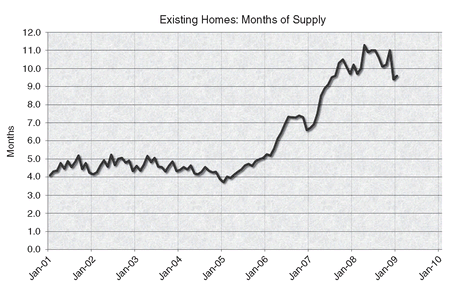Bailout Nation (42 page)
Authors: Barry Ritholtz

But that was
then
. Where does housing fit into the economy in our modern, postbailout world?
then
. Where does housing fit into the economy in our modern, postbailout world?
Today, housing presents a tricky catch-22. Allow me for a moment to be a two-handed economist: On the one hand, housing remains overpriced relative to historic norms; indeed, by nearly every major real estate metric, it has yet to revert to regular pricing levels. One the other hand, as prices fall, that leads to even more foreclosures, causing all manner of problems for the already battered banking sector.
Resolving the current crisisâthe credit markets, the economy, the banking sector, and its toxic derivativesâis dependent on a nearly impossible goal. The ideal solution requires finding a way for home prices to normalize while simultaneously keeping foreclosure rates from spiking. It is quite a sticky balancing act.
Consider how interrelated these various elements are:
⢠Housing is a key part of the economy. Home purchases and refinancings drive other durable goods sales, like appliances, furniture, and automobiles. When housing sales run significantly below trend, as they have over the past few years, the negative economic impact is significant. For the economy to begin improving, housing must stabilize.
⢠During the five-year period from 2002 to 2007, the combination of ultralow rates and nonexistent credit standards created between five and seven million more home buyers than usual. Home ownership rose from 62 percent in 1960 to 66 percent in 2000. It peaked at just over 69 percent in the 2004-2007 period.
3
By Q4 2008, it had slipped to 67.5 percent.
4
3
By Q4 2008, it had slipped to 67.5 percent.
4
⢠The influx of new buyers helped drive prices several standard deviations higher (meaning more expensive than they should be). Even though home prices have since fallen more than 25 percent nationally (according to the Case-Shiller indexes
5
), housing still remains relatively overpriced in many areas.
5
), housing still remains relatively overpriced in many areas.
⢠There have been over two million foreclosures in the United States as of the end of 2008. The many people who bought homes they could not afford are in the process of reverting back to being renters. There may be anywhere from another one to four million more foreclosures in the next few years. As disruptive as foreclosures are to families and neighborhoods, the silver lining is they help drive prices back toward normalized levels.
⢠A recent report by First American CoreLogic determined that 20 percent of homes with mortgages (8.3 million) are underwaterâthe mortgage debt is greater than the value of homes. Call them “home-
owers
.” These properties tend to be at greater risk for walkaways, jingle mail (mailing keys to lender), and foreclosures.
6
owers
.” These properties tend to be at greater risk for walkaways, jingle mail (mailing keys to lender), and foreclosures.
6
⢠There have been over 5.1 million jobs lost so far in the recession that began in December 2007.
7
Employment generally lags the economic cycle, meaning it stays low even after the economy begins to recover. I would not be surprised to see another two to three million more job losses before the recession ends.
7
Employment generally lags the economic cycle, meaning it stays low even after the economy begins to recover. I would not be surprised to see another two to three million more job losses before the recession ends.
⢠Perhaps most significantly, as the recession continues, job losses are still rising and foreclosures increasing. The trillions of dollars in toxic paper held by banks and insurers become worth less and less with each economic downtick. More foreclosures = more bank failures = bigger FDIC/federal obligations.
This helps to explain why the Federal Reserve and the Treasury have been so desperate to stop foreclosures; it is also why the White House was willing to throw $75 billion at a foreclosure abatement program. While the intentions are good, the main issue remains:
Homes are still too expensive
.
Homes are still too expensive
.
This is the heart of our catch-22. It is an issue that seems sacrilegious to many economists:
Home prices remain too high for stabilization and/or a housing bottom to form
.
Home prices remain too high for stabilization and/or a housing bottom to form
.
As
Figures 21.1
to
21.3
show, the wreckage in the real estate sector has brought house prices down from wildly overvalued levels of a few years ago. But they are still too high by most valuation metrics. Consider such metrics as the ratio of median income to median home price, the cost of renting versus owning, and housing capitalization of gross domestic product (GDP); in each of these, home prices are still significantly elevated above historic norms.
Figures 21.1
to
21.3
show, the wreckage in the real estate sector has brought house prices down from wildly overvalued levels of a few years ago. But they are still too high by most valuation metrics. Consider such metrics as the ratio of median income to median home price, the cost of renting versus owning, and housing capitalization of gross domestic product (GDP); in each of these, home prices are still significantly elevated above historic norms.
Figure 21.1
Home Prices as a Percentage of Gross Domestic Product
Home Prices as a Percentage of Gross Domestic Product
SOURCE: Chart courtesy of Calculated Risk,
www.calculatedriskblog.com
www.calculatedriskblog.com

Figure 21.2
Price-to-Rent Ratio
Price-to-Rent Ratio
SOURCE: Chart courtesy of Calculated Risk,
www.calculatedriskblog.com
www.calculatedriskblog.com

Figure 21.3
Home Prices versus Median Household Income
Home Prices versus Median Household Income
SOURCE: Chart courtesy of Calculated Risk,
www.calculatedriskblog.com
www.calculatedriskblog.com

In all of these charts, housing has come about half to two-thirds of the way back into line. But consider this grim reality about future home prices: Markets rarely revert just back to the mean. In most instances where assets have become dramatically overextended (stocks, commodities, bonds, and, yes, housing), the reversion tendency has been to overshoot to the downside.
Therein lies the crux of the problem: Propping up home prices or forestalling foreclosures might only serve to delay the inevitable. To effect true stabilization, including a real housing bottom and recovery, these overpriced assets will likely fall even further. (Either that, or a few million new buyers must come into the market.)
When prices drop enough, good things happen. The prime bubble areasâCalifornia, South Florida, Arizona, Las Vegasâeach suffered enormous foreclosure surges of 80 to 120 percent, followed by huge price decreases of 40 to 50 percent. But now these states contain the few areas of the country where home sales are increasingâdriven by sales of homes in foreclosure.
It's not that people are unwilling to buy real estate in the United States; it's that buyers are unwilling to overpay.
And therein lies the heart of the problem with most rescue plans. They are designed to prevent the continued downward spiral of the housing market, which unfortunately is precisely what is needed. The artificial demand of the ultralow rates and lax lending standards sent prices to unsustainable levels, and put millions of people into homes they could not afford. The markets are correcting these excesses as people trade out of those homes. It is a classic unwind of a bubble.
In much of the country, home prices remain too high, and the overpriced homes are not moving. That's reflected in the huge inventory overhang of unsold homes. (See
Figure 21.4
.) And the inventory data of homes for sale does not include the shadow inventoryâall of the homes purchased as investments, by flippers, as second homes, or as rental units. These owners are waiting in the shadows for the opportunity to get rid of their properties. Any improvement in the real estate market is likely to bring forth this additional supply.
Figure 21.4
.) And the inventory data of homes for sale does not include the shadow inventoryâall of the homes purchased as investments, by flippers, as second homes, or as rental units. These owners are waiting in the shadows for the opportunity to get rid of their properties. Any improvement in the real estate market is likely to bring forth this additional supply.
Figure 21.4
Existing Home Inventory
Existing Home Inventory
SOURCE: Chart courtesy of Calculated Risk,
www.calculatedriskblog.com
www.calculatedriskblog.com

Until prices revert back toward historical norms, the excess inventory will not be removed, the foreclosures will not stop, and the total sales will remain depressed. The sooner Washington, D.C., figures this out, the better off the economy and U.S. homeowners will be.
Real estate is unique. Unlike most goods and services, purchases are not independent from other parties to the sales transaction. Whether you buy 1,000 shares of stock, a used car, or a can of soup, only two parties are involved: the buyer and the seller. But buy a home (85 percent of all sales are existing homes) and you are involved in a transaction chain with four, five, even six or more other buyer/seller pairs.
Consider the newlywed couple who want to purchase a starter home. Their sellers are a family with a child on the way who want to move to a larger home. The sellers of
that
house have two teenage daughters driving them crazy, and they want to move to an even bigger house, whose seller is moving to a waterfront property, and so on. It is often a long chain of trade-ups, with increasing size and cost (and property taxes). The rub is that if any one of these sales falls apart, the entire chain collapses.
that
house have two teenage daughters driving them crazy, and they want to move to an even bigger house, whose seller is moving to a waterfront property, and so on. It is often a long chain of trade-ups, with increasing size and cost (and property taxes). The rub is that if any one of these sales falls apart, the entire chain collapses.
And therein lies the problem.
Go to any suburban neighborhoodâeven the one you live in. Look at the starter homes that our theoretical newlywed couple might consider: small Cape Cod cottages and two- or three-bedroom ranches. Assume that this couple are in their late 20s or early 30s, and are making decent (but not six-figure) salaries. I'm guessing that describes 80 percent of typical newlywed home buyers.
Can they afford that starter house? If not, then the real estate chain is partially frozen. What's left is mostly downsizing, laterals, and moves into different regions. As long as housing remains unaffordable for the majority of first-time buyers, it will significantly reduce total real estate sales.
House sales peaked in 2007 at well over 7 million units. We are now running about 4.25 million sales per year. A more normalized number would be between 5 and 5.5 million. That's not going to happen if the starter home market is dead. If the newlyweds cannot afford that first purchase, the entire chain gets bogged down.
How can we reduce foreclosures
and
lower home prices?
and
lower home prices?
The real estate market would be much better off if policy makers recognized three things:
1. Falling prices help return the housing market to normalcy.
2. Those people who cannot afford to be in their houses (underwater, overpriced, too little income) should be helped to move into affordable housing (rental or purchased); keeping people in homes they cannot afford is counterproductive.
3. Those people who can afford to stay in their homes with a loan modification or workout are the best targets for legitimate foreclosure avoidance.
If they could, banks would prefer to avoid foreclosure. It's an expensive, time-consuming process; properties acquired through foreclosure are a messy, money-losing headache. Any intelligent proposal to reasonably avoid preventable foreclosures would give the banks a big incentive to voluntarily participate in loan modifications. I believe this is just such a plan.
Other books
The Rebel Spy by London, April
The Last Stand: Custer, Sitting Bull, and the Battle of the Little Bighorn by Nathaniel Philbrick
Ransom by Denise Mathew
Those Endearing Young Charms by Marion Chesney
India After Gandhi by Ramachandra Guha
OwlsFair by Zenina Masters
Her Alpha Lover: A Draken and Charli Boxed Set by Richensexi, Amanda
The Invasion by K. A. Applegate
Let's Play Ball by Lolah Lace
Rich and Famous by James Lincoln Collier
